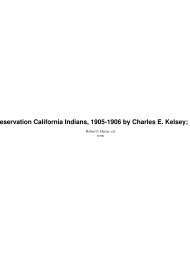Spring 2008 - Yosemite Conservancy
Spring 2008 - Yosemite Conservancy
Spring 2008 - Yosemite Conservancy
- No tags were found...
You also want an ePaper? Increase the reach of your titles
YUMPU automatically turns print PDFs into web optimized ePapers that Google loves.
Above left: <strong>Yosemite</strong>’s original human inhabitants regularly set fire to the Valley floor to encourage the growth of grasses and oaks. Here,<br />
their descendants use traditional methods to ignite a prescribed burn. Above right: Park staff monitor the progress of the prescribed burn.<br />
tem as possible. Those tools have expanded to include not<br />
only fire suppression, but fuels reduction and management<br />
of naturally-ignited fires.<br />
Fuels reduction can be accomplished in a variety of<br />
ways. One method involves mechanically cutting up<br />
brush, trees and downed logs, and either piling them<br />
for burning or hauling them away. This technique can<br />
reduce larger diameter fuels such as snags and downed<br />
logs, but does not reduce levels of duff and smaller forms<br />
of forest litter that have accumulated. Prescribed fire can<br />
reduce fuels of all sizes but is a much riskier practice.<br />
There is always the danger of a fire escaping planned<br />
boundaries, while the resulting smoke can be a nuisance<br />
or health threat. Before land managers burn, they develop<br />
a prescribed burn plan based on a prescription: a set of<br />
weather, fuel and resource parameters that are aimed at<br />
achieving a particular goal.<br />
All of this is made more complicated by fuels that have<br />
accumulated over the past hundred years of successful fire<br />
suppression. Fire introduced to such fuel-loaded landscapes<br />
has the potential to burn too hot or for too long,<br />
damaging the ecosystem’s ability to rejuvenate. While<br />
early fire managers worried over how to put fires out,<br />
determining which land management objectives are most<br />
important and how to meet them are two of the most difficult<br />
challenges that fire managers face today.<br />
In the fall of 2005, the National Park Service conducted<br />
a prescribed burn in a thirteen-acre wetland<br />
meadow in <strong>Yosemite</strong> Valley. Like much of <strong>Yosemite</strong> Valley,<br />
the meadow historically had been managed and used by<br />
American Indians. These resources are still used by the<br />
descendants of the Valley’s original inhabitants as well<br />
as the Park’s Indian Cultural Demonstration Program.<br />
A century and a half of fire suppression, however, had<br />
allowed thatch to accumulate, invasive Himalayan<br />
blackberry to spread into the meadow, and conifers to<br />
encroach. The presence of an old road and its culvert further<br />
accelerated these changes by disrupting the natural<br />
flow of water through the area. The compounded effect<br />
of changes to the natural fire regime and the altered<br />
hydrology of the site threatened populations of traditionally<br />
gathered plants, and posed a complex restoration<br />
challenge.<br />
The National Park Service coordinated with other<br />
park partners, including the <strong>Yosemite</strong> Fund, <strong>Yosemite</strong><br />
Institute and local Native American tribes, to put together<br />
a long-term restoration and research effort addressing<br />
many of these concerns. Although the meadow was once<br />
maintained by regular burning, fire alone was no longer<br />
enough to restore the area with native plants. Scientific<br />
literature reports that Himalayan blackberry will resprout<br />
vigorously after burning, which in turn suggested that<br />
removing the blackberry first was imperative. To determine<br />
which approach would be most effective, park staff<br />
and volunteers pulled the blackberry before the burn in<br />
some areas and simply burned it in others. The study<br />
would also track the response of traditionally gathered<br />
plants to the different treatments.<br />
The Park Service invited tribes having ancestral<br />
cultural associations with park lands to participate in<br />
the prescribed burn. The fire was lit using a traditional<br />
friction method as representatives of the tribes offered<br />
prayers and songs. The igniter rapidly rolled a pointed<br />
stick between his hands with the point pressed firmly into<br />
a plank of wood. When the heat had built sufficiently, the<br />
stick tip was used to ignite a wad of shredded cedar bark<br />
8 YOSEMITE ASSOCIATION, SPRING <strong>2008</strong>


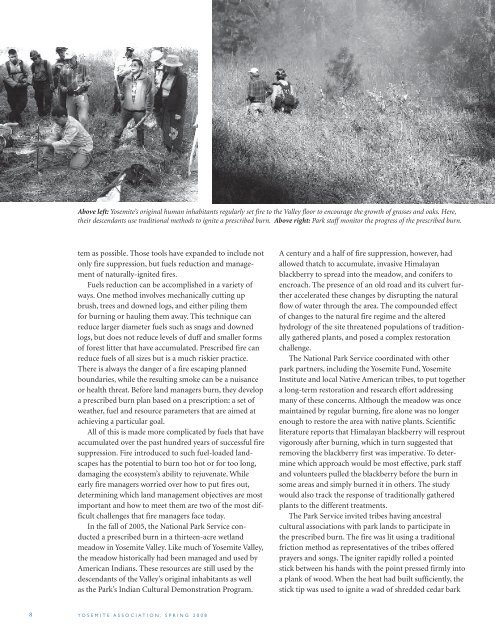

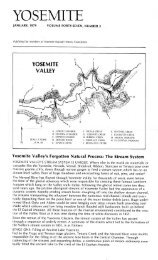
![(March 1982) [PDF] “We Are Pleased to Announce†- Yosemite Online](https://img.yumpu.com/51299748/1/190x242/march-1982-pdf-aeuroewe-are-pleased-to-announceaeur-yosemite-online.jpg?quality=85)
![[PDF] Old Horny, Yosemite's Unicorn Buck - Yosemite Online](https://img.yumpu.com/51269869/1/184x260/pdf-old-horny-yosemites-unicorn-buck-yosemite-online.jpg?quality=85)
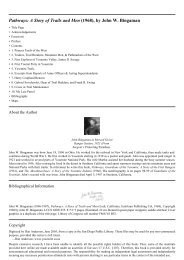
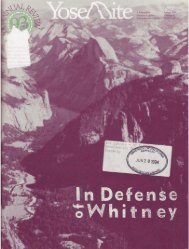
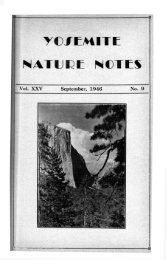
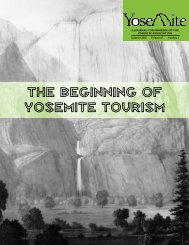
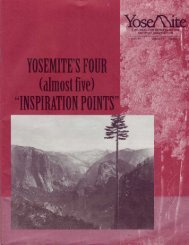
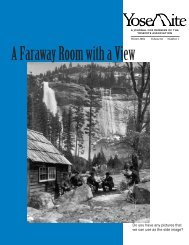
![1985 [PDF] - Yosemite](https://img.yumpu.com/48128837/1/184x260/1985-pdf-yosemite.jpg?quality=85)

